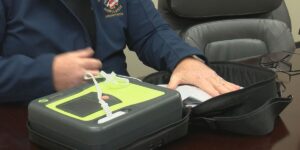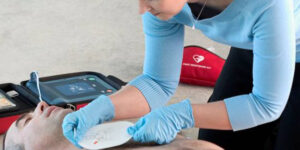In emergency situations, every second counts. Sudden cardiac arrest is a leading cause of death worldwide, and immediate intervention is crucial for saving lives. External defibrillators, also known as automated external defibrillators (AEDs), play a critical role in restoring normal heart rhythm and increasing the chances of survival for individuals experiencing cardiac arrest. In this comprehensive guide, we’ll explore the importance of AEDs in emergency situations, how they work, where they are commonly found, and how to use them effectively.
1. Understanding Sudden Cardiac Arrest
Sudden cardiac arrest occurs when the heart suddenly and unexpectedly stops beating. This can be caused by an electrical malfunction in the heart that disrupts its normal rhythm. Without immediate intervention, sudden cardiac arrest can quickly lead to death. Common symptoms of sudden cardiac arrest include:
- Sudden loss of responsiveness
- Absence of normal breathing
- Loss of pulse
2. The Importance of Immediate Intervention
Immediate intervention is crucial for increasing the chances of survival for individuals experiencing sudden cardiac arrest. For every minute that passes without treatment, the chance of survival decreases by 7% to 10%. After 10 minutes, the chances of survival are very low.
3. The Role of External Defibrillators
External defibrillators, or AEDs, are portable electronic devices that can automatically diagnose and treat life-threatening cardiac arrhythmias, including ventricular fibrillation and pulseless ventricular tachycardia. AEDs deliver a therapeutic dose of electrical energy to the heart, helping to restore normal heart rhythm.
4. How AEDs Work
AEDs are designed to be user-friendly, even for individuals with minimal or no medical training. Here’s how they work:
- Automated Operation: AEDs are designed to be automated, meaning they can be used by laypeople with minimal training. The device provides audio and visual prompts to guide the user through the process.
- Electrode Placement: The AED comes with adhesive electrode pads that are placed on the patient’s chest. The device uses these electrodes to analyze the heart rhythm and deliver a shock if necessary.
- Rhythm Analysis: The AED automatically analyzes the patient’s heart rhythm to determine if a shock is needed. If a shockable rhythm, such as ventricular fibrillation or pulseless ventricular tachycardia, is detected, the device will prompt the user to deliver a shock.
- Shock Delivery: If a shock is advised, the AED will prompt the user to stand clear and deliver a shock to the patient’s heart. The shock temporarily stops the heart’s electrical activity, allowing the heart to reset and resume normal rhythm.
- CPR Integration: Many AEDs are equipped with CPR prompts, providing guidance on performing cardiopulmonary resuscitation (CPR) in conjunction with defibrillation.
5. Where AEDs are Found
AEDs are commonly found in public places where large numbers of people gather, such as:
- Airports
- Shopping malls
- Office buildings
- Schools and universities
- Sports stadiums
- Gyms and fitness centers
- Community centers
- Hotels and resorts
6. How to Use an AED
Using an AED is simple, even for individuals with minimal training. Here’s a step-by-step guide:
- Step 1: Turn on the AED: Press the power button to turn on the AED.
- Step 2: Attach the Electrode Pads: Peel the backing off the electrode pads and place them on the patient’s bare chest, following the placement diagrams on the pads.
- Step 3: Analyze the Heart Rhythm: The AED will analyze the patient’s heart rhythm and determine if a shock is needed. Make sure no one is touching the patient and press the analyze button if prompted.
- Step 4: Deliver the Shock: If a shockable rhythm is detected, the AED will prompt you to deliver a shock. Make sure no one is touching the patient and press the shock button as directed.
- Step 5: Perform CPR: If instructed by the AED, perform CPR until emergency medical help arrives.
7. AED Maintenance and Training
It’s essential to ensure that AEDs are properly maintained and that individuals who may need to use them are trained in their operation. Here are some important considerations:
- Regular Maintenance: AEDs should be regularly inspected and maintained according to the manufacturer’s guidelines. This includes checking the battery, electrode pads, and overall functionality of the device.
- Training Programs: Many organizations offer training programs in CPR and AED use. These programs are designed to teach individuals how to recognize a cardiac emergency, perform CPR, and use an AED effectively.
- Accessibility: AEDs should be easily accessible and clearly marked in public places. It’s essential to know the location of the nearest AED in case of an emergency.
8. Conclusion
External defibrillators play a crucial role in saving lives during sudden cardiac arrest. By providing immediate intervention and restoring normal heart rhythm, AEDs increase the chances of survival for individuals experiencing cardiac emergencies. It’s essential for individuals to be familiar with the location and operation of AEDs, as well as to receive training in CPR and AED use. With proper preparation and access to AEDs, communities can improve outcomes for individuals experiencing sudden cardiac arrest and increase the chances of survival in emergency situations.




